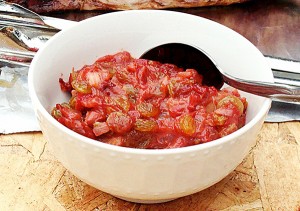Home »

Rhubarb, the undemanding and low maintenance early riser
By Kerstin Renner
Early in the growing season, crops are still scarce, but there is one plant that sends up its bright red, crisp shoots as soon as the ground thaws out.
This plant, of course, is rhubarb and some gardeners may even be able to harvest the first stalks soon. If you do not have a rhubarb plant yet, you should really consider adding one to your garden; it may even be grown in a large container.
There are a lot of plants that garden gurus claim to be ‘undemanding’ and ‘low maintenance.’ Rhubarb certainly deserves both those designations. In fact, a certain person in my household tried to – shall we say – “discourage” my rhubarb from growing. Even without watering and an overturned picnic table resting against the shoots, the plant did not give up. It has now earned its rightful place in the garden and will no doubt be giving us a good harvest this season.
For best results, rhubarb should be planted in a sunny location in the garden. The soil should be fertile and well drained. Rhubarb grows large and very fast and one plant is usually enough for a family.
To plant rhubarb, first prepare a hole two feet deep and fill the bottom half with a mixture of composted bark mulch, manure and soil. Plant the rhubarb crown two inches below the soil level, and firm evenly around the root. Soak the planting area with diluted, liquid transplanter fertilizer. Rhubarb plants are heavy feeders and need regular feeding each spring with a balanced fertilizer.
The first year after planting, do not harvest the plant, giving it time to build strength for the following years. In the second year, light harvesting should be done. After that, you will be able to harvest as much as you possibly need, making sure to take only about one third of the plant at a time.
Harvest only the thick, succulent leaf stalks and leave smaller, slender stalks to supply nourishment to the roots. To harvest, grasp the stalks firmly and pull steadily. Do not twist, jerk, or cut them. You should never eat the leaves, as they contain calcium oxalate, which in sufficient amounts can be quite harmful.
The most common use for rhubarb is cut into pieces and cooked with sugar or made into pies and jams. How about a savory idea this season? This rhubarb chutney goes well with barbecued meat or even a cheese platter.
Rhubarb Chutney
 Wash and peel two pounds of rhubarb and cut the stalks into small pieces. Finely chop one large onion. Combine rhubarb, onion as well as a half cup of sultana raisins, one tablespoon of mustard seeds, two teaspoons of ground ginger, one teaspoon of ground cinnamon, one tablespoon of salt, one tablespoon of pepper and 1.5 cups of vinegar in a large pot and bring to a boil. Then add about three cups of brown sugar and let mixture simmer until it is the consistency of jam, stirring occasionally. If you like a bit more heat, you can add cayenne pepper to taste. Fill hot mixture into sterilized canning jars, seal and store.
Wash and peel two pounds of rhubarb and cut the stalks into small pieces. Finely chop one large onion. Combine rhubarb, onion as well as a half cup of sultana raisins, one tablespoon of mustard seeds, two teaspoons of ground ginger, one teaspoon of ground cinnamon, one tablespoon of salt, one tablespoon of pepper and 1.5 cups of vinegar in a large pot and bring to a boil. Then add about three cups of brown sugar and let mixture simmer until it is the consistency of jam, stirring occasionally. If you like a bit more heat, you can add cayenne pepper to taste. Fill hot mixture into sterilized canning jars, seal and store.
– Kerstin Renner completed a degree in journalism and communications, before working at the local radio station and most recently as editor of the Kootenay News Advertiser with a stint at the Regional District of East Kootenay thrown in. Now she gets to nurture her green(ing) thumb at Top Crop Garden, Farm & Pet and pass on the knowledge she is soaking up by writing about growing.








